This blog is about an extraordinary textile tour to Bhutan. Organised through Bhutan & Beyond www.bhutan.com.au, we had Wendy Garrity as our textile expert www.textiletrails.com.au. Wendy had lived for 2 ½ years in Bhutan and has become expert in the technique of kushü. We had the services of a wonderful support staff in Bhutan with extra special accolades going to our guide, Tshering Gyeltshen (email tgyeltshen@hotmail.com) I can highly recommend him if anyone is going to Bhutan. He certainly facilitated a great trip and as an added bonus understood weaving. His wife and mother wove. He was also very obliging especially when it came to shopping and our need to find out price.
My blog as usual is about textiles but before I begin, I’ll share just a snapshot of some scenery and some details to provide background colour.
Bhutan is a land of stunning scenery; of deep valleys and perhaps snow-capped mountains;
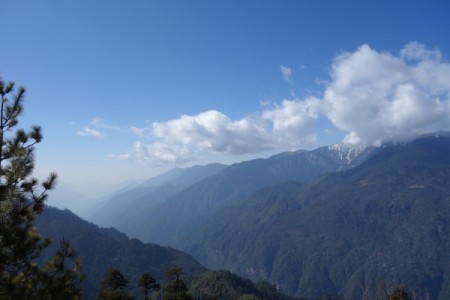
of challenging roads that zigzag up and down mountains

and of roads being made. Currently a ‘road widening program is being undertaken on the main road from one end of the country to the other. Challenging could be applied to travel. It may take 8 hours to drive 200km.
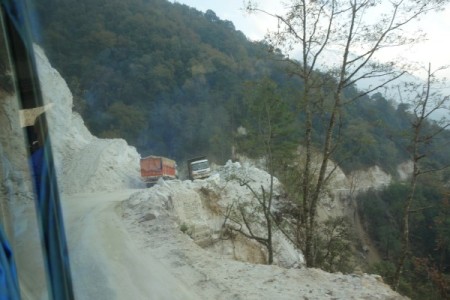
It’s a country of where the king is revered. His image/s appears on public buildings, in restaurants and shops, on the entrance to towns, on mountain passes.
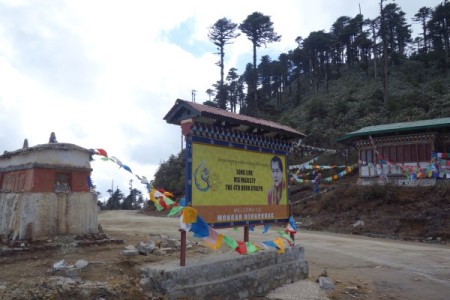
It is a Buddhist country where religion is important. Monks are a part of everyday society. Here at the largest Buddhist Statue of Guru Rinpoche also known as Padmasambhava standing at 49m, there was a week of religious study being undertaken by both monks and the lay in a huge covered area. There must have been hundreds of people listening. I have included this image also because of the sign and the awareness of rubbish disposal. For this event at this statue the potential for generating a lot of rubbish is huge. In villages monks are a part of community.
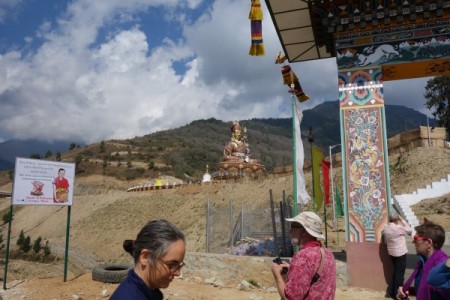
The church and the state are equal in respect and daily life. The Panakha Dzong is recognised as the most beautiful Dzong in the country and has an alternative name which translates to “Palace of Great Happiness”. It was the capital of Bhutan until 1955 and is also the winter residence of the central monk body.
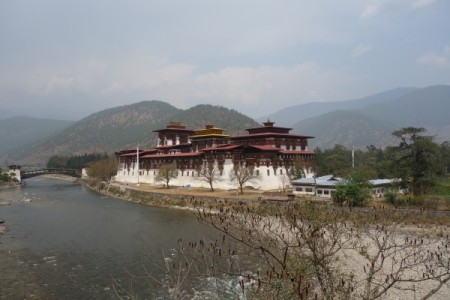
It was spring and trees were starting to flower. Jowo Temple of Kyichu.
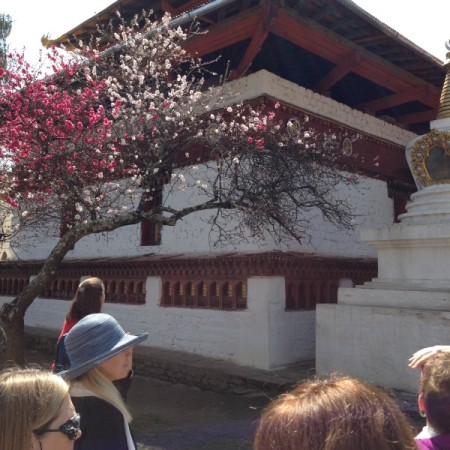
And a whole hillside of ‘magnolias’ and indigo. These looked like the familiar bauhinia trees of Queensland grown often as street trees so they are tough. When researched the bauhinia originates from India, so they are probably native to here too. Our guide said that this was also referred to as magnolias. They have true magnolias here too.
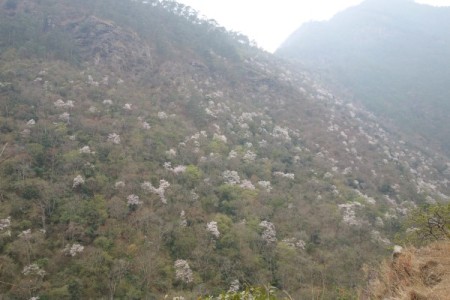
Some fields were unplanted though in the south where it was warmer, crops were growing. Here barley was being grown.
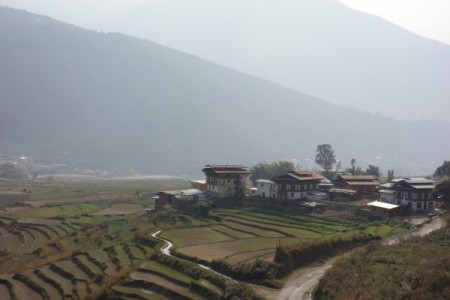
It’s a place of distinctive architecture with laws ensuring the maintenance of the Bhutanese style. This is one of the hotels we stayed in. Painted decoration on buildings abound.
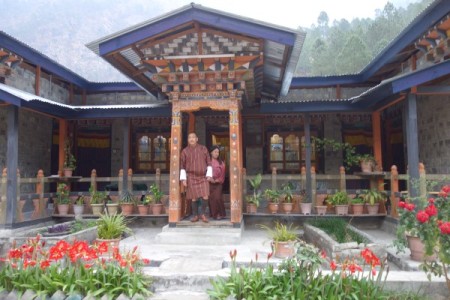
Rocks on the roof were a common occurrence to keep it anchored.
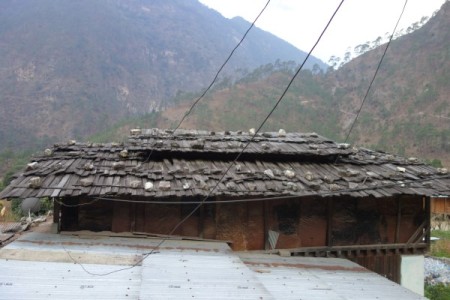
Prayer flags of many types abound; whether these small rectangular ones, or long white funeral prayer flags or shorter rectangular coloured ones. Wendy supervised the adding to the collection at the top of a pass ably assisted by members of our group.

And this is the sound that I’ll always associate with Bhutan: the sound of temple and water wheels.
But it is the textiles that we went to explore. They are a part of everyday life. Anyone in public office is required to wear the kira (female outfit) and the gho (man’s tunic). (I have seen gho spelt go but have taken the spelling from a publication by the Royal Textile Academy). It’s a must for religious ceremony and for festivals. It is worn when communities get together. The people are extremely proud of their national dress. In the country we saw more traditional dress than not. Western dress is often worn in the home and more commonly by the younger generation in informal life. Both provide a feast for the eyes. The following are some examples.
Students at school wear the kira and gho.
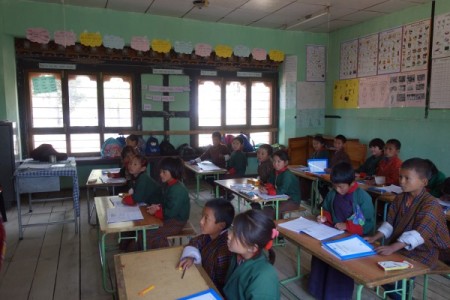
The gho is worn at an informal archery competition between villages.
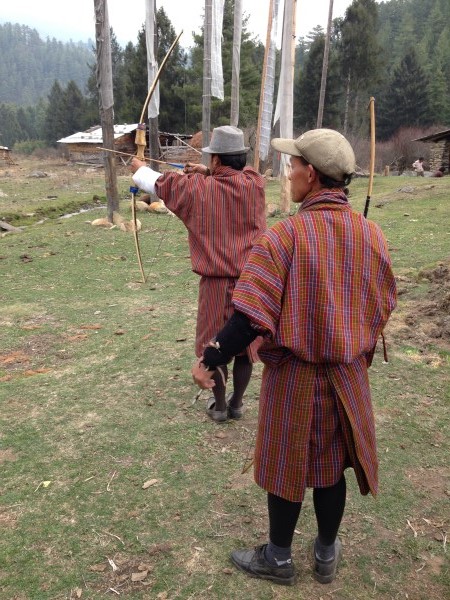
At the Paro Festival everyone was dressed in their finest- the audience

and the performers
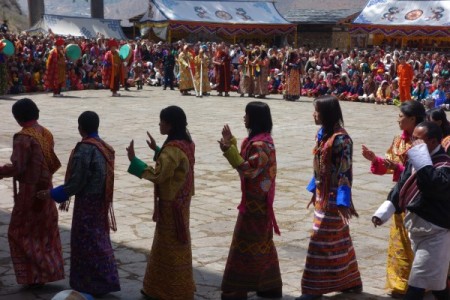
Stephanie, one of our group also dressed the part. This was greatly appreciated by the Bhutanese. As they walked passed, if the scarf wasn’t exactly right, they’d stop her and adjust it. They took delight in being photographed with her.
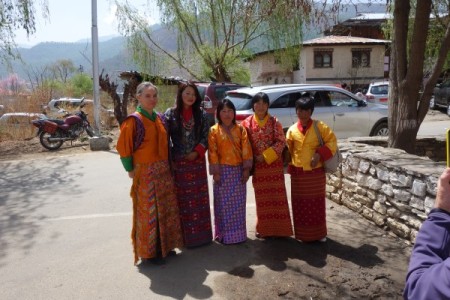
Watch the movie and appreciate the passing pageantry. This was a formal section of the festival where a huge banner that had been hung at midnight was then refurled at around dawn before being taken back with ceremony for storage. It was considered to be good luck to help carry it. Our guide is very excited as he got to help in the carrying up the hill.
I must brag: This was the second major event that we were lucky enough to be present for. Our timing was perfect for both. Just a few minutes earlier when we were walking up the hill to attend the dance performance and met this ritual on the way down, we had also met the king also on his way down. We were greatly honoured that he spoke to us and in fact spoke to everyone in the main who lined the path. I can say that he was extremely gracious and dignified and was dressed in a gho of the most glorious brilliant citric yellow with a touch of turquoise. He was spectacular! No photography was allowed unfortunately, but there were many official photographers in attendance.
The following sequence is of our driver being dressed in the gho with explanations by Tshering.
The gho is put on. As you can see it’s rather large and long. The right hand side is wrapped tight across the front under the left hand side.
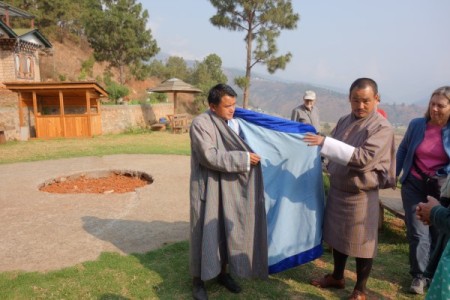
The left is then wrapped tight around the body.

The hems are checked to be level and sitting right.

The surplus fabric at the back s folded into a pleat. In sewing terms this would be a box pleat. The height of the tunic is adjusted.
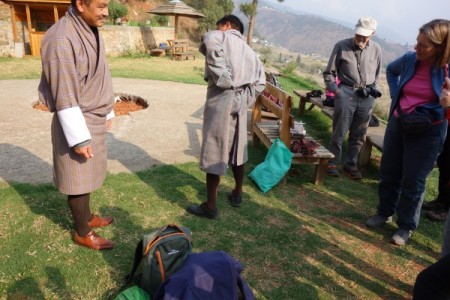
The belt is wrapped around keeping everything in place.
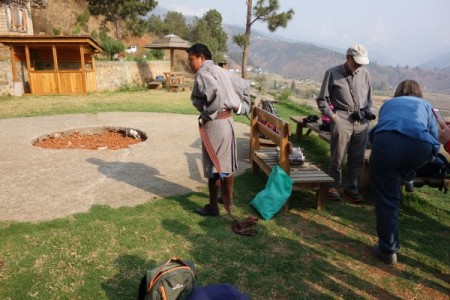
Lastly the white cuffs are added. These are attached by a safety pin and can be changed when they get dirty. They also protect the sleeves of the garment.
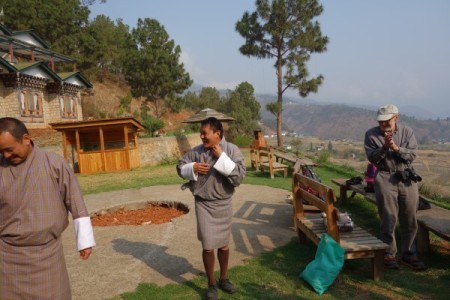
“When visiting a temple or government office, or when paying a call on a social superior it is necessary to wear a ceremonial shawl” Royal Textile Academy catalogue, Thangzo, pp24. The man’s shawl or kabney is a wide plain weave length of cotton or natural silk. Colour denotes status. The general male population wear this cream one. There is a very precise way to put these on. 
The following is of one of our group being dressed in the kira, a dress made from a long wide rectangular cloth.
The fabric is wrapped around the body with a corner positioned slightly forward on the left shoulder. The corner is then secured to the fabric at the front with a broach.
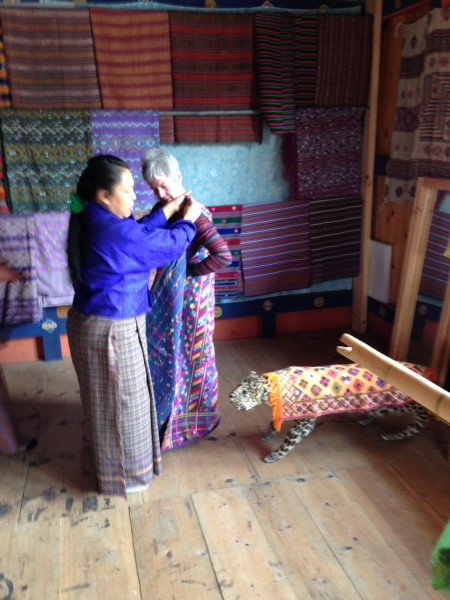
She then brings the other end around the body securing the corner on the right shoulder with a matching broach. The excess folded fabric is straightened, the garment is pulled up to the correct length, and then adjusted so that its stripes or pattern are nicely aligned where the layers of fabric meet at her right hip.
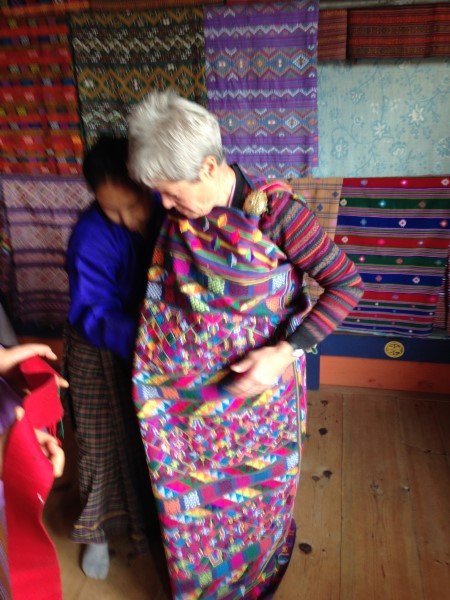
The belt is wrapped around keeping everything in place.
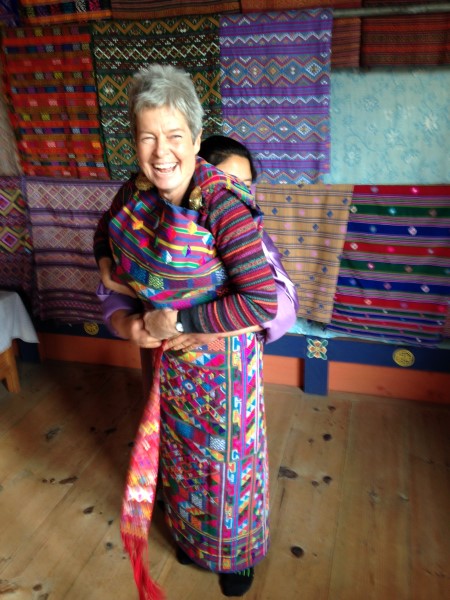
Lastly a jacket adds to the ensemble. A shoulder scarf (rachu) would also be required for formal occasions. This can be seen in other images.
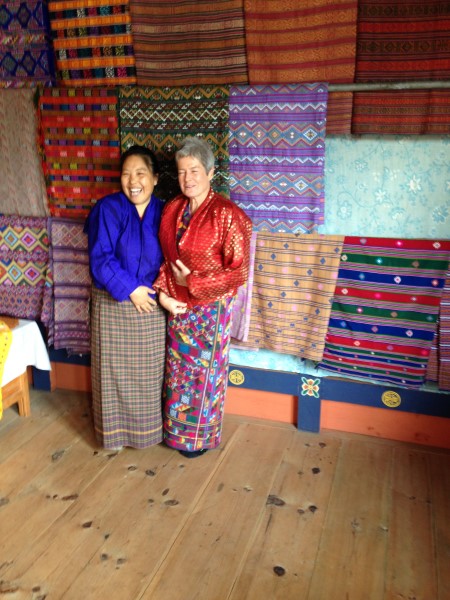
Now for a closer look at the weaving. Firstly some interesting background. We met with Patrizia Franceschinis (back right dressed in Kira and green jacket) who is the Italian wife of one of the ministers in the former government and spent an afternoon with her.

She provided all manner of interesting background information on life in Bhutan. She also collects significant textiles and employs a weaver (front). According to her, weaving is done in areas with no agriculture. Bhutanese textiles possibly predates C8th and one of the main purposes for textiles was for trade. She explained that significant textiles might be traded across and down generations and were given as significant gifts.
Later, we saw evidence of a husband looking after the children while the mother wove. She was in this case the major source of income. The Bhutanese recognise the value of textiles. Textiles are considered to be one of the highest forms of art and spiritual expression. Bhutanese recognise the financial value of textiles and explains why Bhutanese textiles are regarded as ‘expensive’ by western shoppers.
I will give an overview of the textiles that we saw: techniques and where we saw them.
Kushü
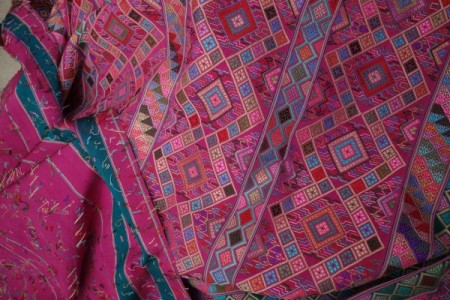
Kushü is a discontinuous weft technique that involves wrapping or twining woven on a warp faced fabric (backstrap loom). We saw these in the private collection of Patrizia Franceschinis in Thimphu. In Thimpu, we also saw them being woven at the Gagyel Lhundrup Weaving Centre where Wendy had learnt to weave. Note the thread tails left hanging.
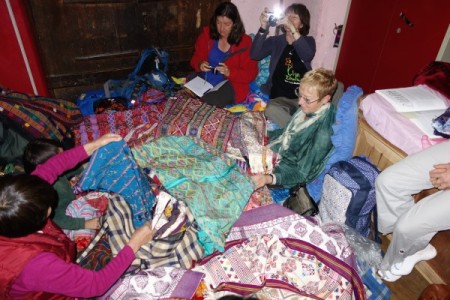
Kushü was being made further east in Khoma and had the opportunity to buy from local villages. According to my research, this northern central area is known for kushü. It was also being woven at Leki (Choekhor Valley) and in the Chencho Handicrafts, Paro. The most celebrated of the kushü weavings is used for the woman’s dress or kushüthara( means brocaded dress). There were many examples at Paro’s Festival. Kushü appeared to be the most prevalent technique for formal women’s textiles.
Aikapur or supplementary warp patterned fabrics.
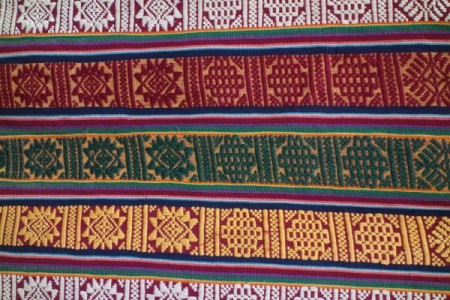
Aikapur features alternating bands of plain weave and supplementary warp on plain weave). The fabric is warp faced (backstrap loom. This technique is often used for the gho and we saw this style of fabric being used across Bhutan.
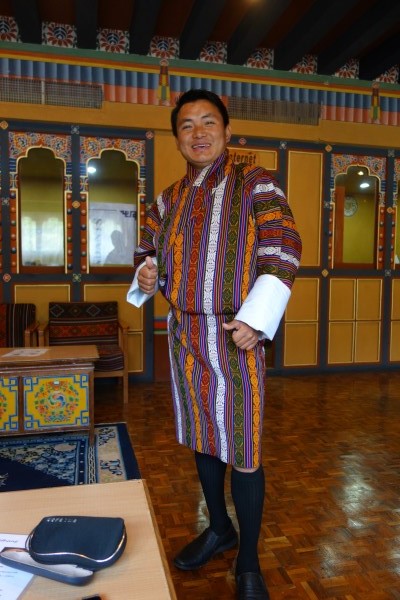
Our driver proudly models his gho. This was a special one that he put on for the Paro Festival. On other days he wore a checked gho. The width of the pattern band and by association the ‘legs’ of the pattern denotes status. ‘Legs’ can be loosely interpreted as pattern blocks. Patterns with 9 or more ‘legs’ are highly regarded as they are more complex in design.
Discontinuous Supplementary Weft
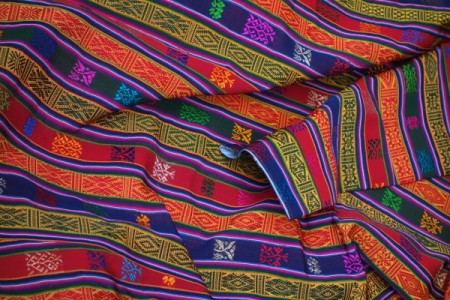
According to Myers and Bean “From the Land of the Thunder Dragon” these have only appeared since the 1940’s. Blocks of motifs have appeared between the stripes on the warp faced striped fabrics and can only be seen on one side (backstrap loom). In eastern Bhutan, they may be referred to as ‘designs in blank spaces’ or tongpang rigpa and in the west as ‘having little boxes’ or dromchu chema.
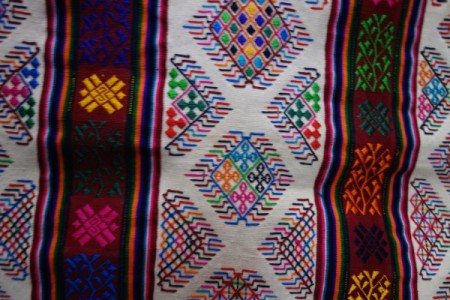
We saw it used predominantly with the supplementary warp stripes. It may be used on its own for kera, the traditional women’s belt. We saw it being woven in the Gagyel Lhundrup Weaving Centre and at Pat Patrizia Franceschinis in Thimphu, and examples at Leki Textiles.
Yathra textiles
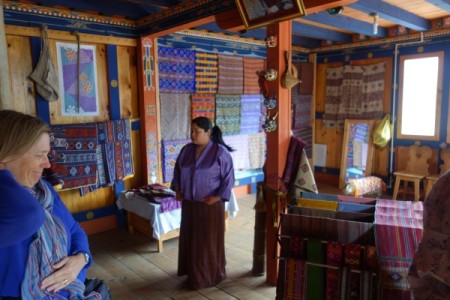
Yathra (hanging on the wall at the left in Leki Textiles gallery) are woven from wool, have weft stripes and discontinuous weft patterning on a twill ground. They were mainly seen in the Bumthang district of central Bhutan. It was woven on either the back strap or more commonly the frame loom from Tibet.
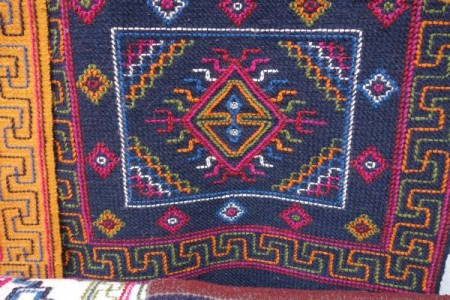
These were without weft stripes. We saw them being woven at the Thokmed Yeshey Handicraft & Yathra Centre at Chumey, Bumthang, at a roadside stall at a pass between Mongar and Checkor Valley and at the Chencho Handicrafts, Paro.
‘Everyday Textiles’
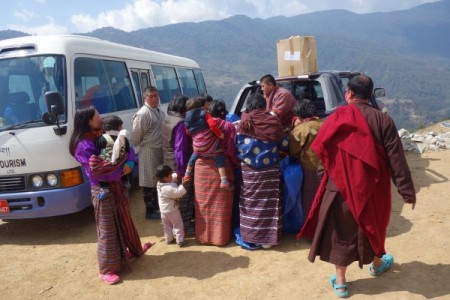
‘Everyday textiles’ was the description given to plain weave checks and stripes in a balanced weave structure (warp and weft can be seen) found in the Chencho Handicrafts, Paro. At this craft centre, these were woven on 4 shaft frame loom. Here 3 very narrow widths went to make up the useable width.This image shows a mix of dress including a checked gho and skirt. In previous images our guide and driver also wore these plain weave textiles. I must admit I didn’t take too much notice of these ‘everyday textiles’ when there was so many other different textiles to notice.
Handspun handwoven yak hair
Along the road in the Bumthang region we came across a yak lady herder who had these hand woven, hand spun purses for sale (as well as very hard yak cheese).
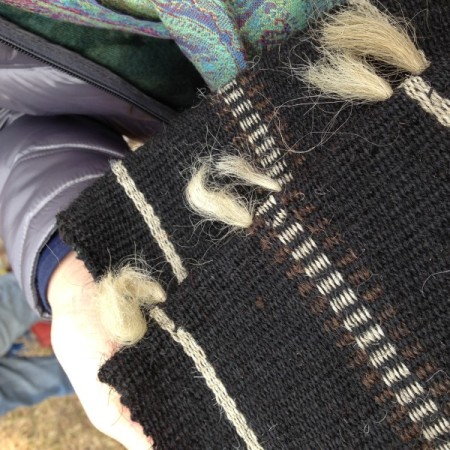
Checks with supplementary weft
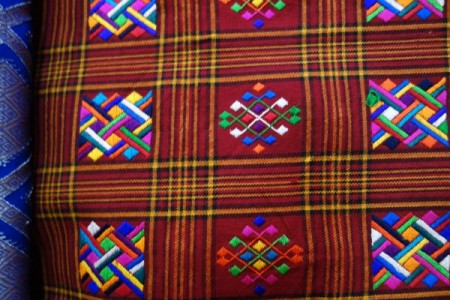
While we didn’t see this being woven, it is a very striking effect. This was found at Leki’s and I presume is woven on a frame loom. I also saw it in Paro. I presume the technique is from central Bhutan
Leno
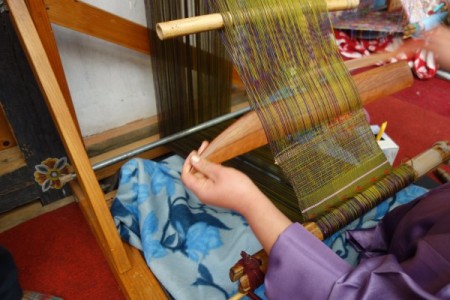
This is a modern technique from Leki. According to Rinsin (our contact at Leki) this technique was introduced about 11 years ago by an NGO. It probably came from the south. It’s a hand worked leno done on a backstrap loom.
Warp Patterning
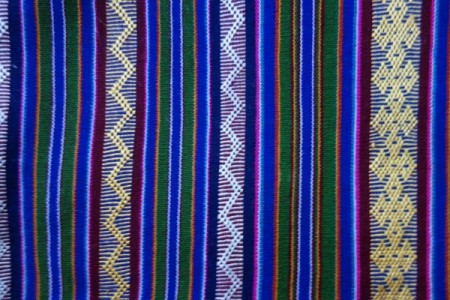
I couldn’t believe my eyes. This is not a technique that I’d researched from here. I found it at the Gagyel Lhundrup Weaving Centre in Thimphu. It’s similar to a technique from Timor and Nth Vietnam and even the pebble weave of South America. It is not supplementary but rather manipulation of warp threads in an alternating colour sequence. According to the weavers it was also introduced by an NGO in the south, possibly Samdrup Jongkhar which borders India and has made its way north. To all appearances it fits neatly into the overall effect of Bhutanese textiles but its introduction hasn’t been a success.
Embroidery
Between Trongsa and Panukha at a roadside restaurant and handicrafts shop, we saw these two girls doing embroidery under the supervision of a Master Embroiderer. This work was for a wall hanging.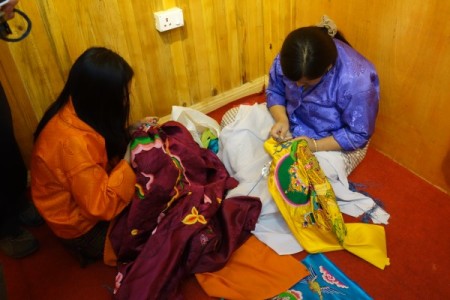
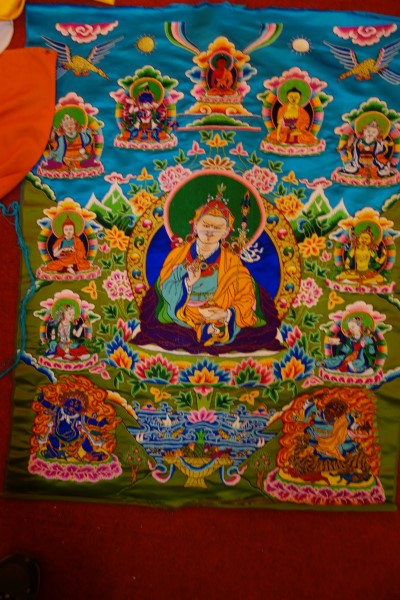
Card woven belts
An example can be seen in the belt in the demonstration of how to put on a kira above. They are woven on the same back strap loom used for other weaving. One end of this belt has several different patterns, the middle has no pattern and the other end has one pattern repeated.
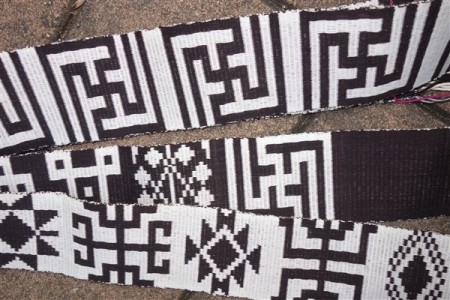
Pile Rugs
I saw small rugs being woven in Chencho Handicrafts, Paro. These were being woven on a vertical frame loom in the pattern style of the yathra. The woman who was weaving them said that they came from her mothers home town. I think that I also remember seeing them for sale in the Thokmed Yeshey Handicraft & Yathra Centre at Chumey. Unfortunately I didn’t record an image. Therefore I presume they may be being woven in central Bhutan.
Places of interest
So far I have mentioned a number of places where we experienced weaving. The following is a list.
National Textile Academy, Thimphu: exhibitions, retail outlet and school. Arrange for a guided tour. B
Gagyel Lhundrup Weaving Centre, Thimphu: weaving studio and retail outlet. B
Leki Textiles, Bumthang: weaving studio, workshops (weaving and dyeing), retail outlet.C
Thokmed Yeshey Handicraft & Yathra Centre at Chumey, Bumthang: retail outlet with weaving centre. C
Chencho Handicrafts, Paro: studio, retail outlet. A
The village of Khoma. It’s a recognised “textile village” specialises in Kushü. Also gateway to other weaving villages/ groups. D
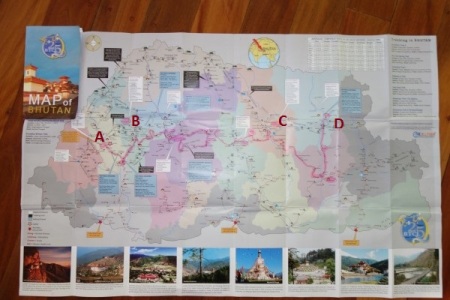
This map shows our journey from west to east and back again as well as identifying where the above places of interest were. It is also worthwhile to note that village handicraft shops and roadside stalls also had weaving.
References
“From the Land of the Thunder Dragon: Textile Arts of Bhutan” edited by Diana K Myers and Susan S Bean. Serindia Publications, London. 1994, ISBN 0 906026 33 4
“Grace of the Kira: Bhutan’s Textile Heritage” David K Barker, 2013 To order www.Xlibris.com
“Thagzo: The Textile Weaves of Bhutan” published by Royal Textile Academy, 2013, ISBN 978-99936-912-0-4 (catalogue)
CD “ An Introduction to Textiles of Bhutan” The Textile Museum, Thimphu, Bhutan.
The next blog will cover the actual textile production.
Thank you Kay. A wonderful weaving journey.
Thanks Carol,
I want to take this opportunity to thank you so much for a wonderful afternoon in Vientiane at your place. I just loved hearing your stories especially of how you fitted into Laos and your journey there through textiles. So much to talk about and the afternoon just flew! Good luck also on your Cambodia project. I hope we meet face to face again. Kay
Love your blogs Kay and the information in them. I look forward to them arriving….Pauline
Hi Pauline, I’m pleased you are enjoying them. Lets catch up soon. Kay
What a fantastic journey. Thank you for sharing it with us, Kay. I will look at this 2-part blog again and again. It is full of many riches: in fabrics, culture and scenery.
When following your blog, I sometimes think back to the first weaving workshop I attended with you at Sturt… I was so overwhelmed with terminology and ideas, but now it is a joy to read and comprehend. Thank you for being a major part of my weaving journey!
I appreciate your comment very much Jim. It’s always an interesting exercise post trip reviewing information and in some ways it gives me a way to relive it while the memories are fresh. I am very happy to share this wonderful journey (and the Laos leg). I knew I’d have to split it into 2 as there was just so much.
Thank You so much for sharing ‘how to wear’ these traditional garments, both men and womens! Books and images abound of woven textiles, but how to dress from the locals themselves is rare and priceless!
I agree. Thanks for the comment.